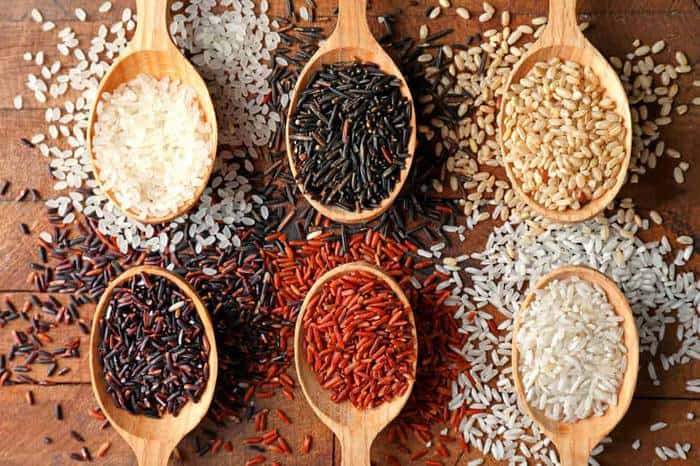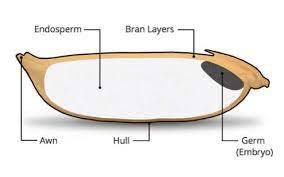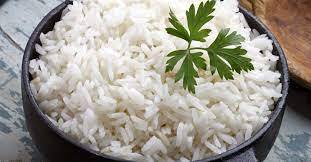Rice has been consumed as a major food item for more than 8000 years. It is one of the most simple foods. It is the seed of aquatic grass named Oryza Sativa.
Types of rice
Various types of rice available can be differentiated based on their colour, texture and taste.
Arbiro rice
This type of rice is white in colour and contains very high quantities of starch. It is generally used for making creamy dishes like risotto.
Basmati rice
This rice originated in India and is widely consumed in Indian households. It is a long-grain rice that is generally consumed with pulses.
Black rice
As the name suggests, the colour of this rice is black. The taste of black rice is very earthy and nutty. It contains antioxidants like anthocyanins which are responsible for its black colour.
Jasmine rice
This rice originated in Thailand but is very similar to Basmati rice. It is nutty and aromatic.
Brown rice
This rice is healthier than any white rice. It is rich in phosphorus, magnesium and potassium. People have started substituting white rice with brown rice due to its nutritional value. As they say, brown rice is the new white rice.
Features
Rice is the staple food of nearly half of the world’s population. It is consumed differently all over the world. Rice can be cooked by boiling or it can even be ground into flour. It is used differently for making soups, main course, starters, cereals, noodles and even for alcoholic beverages.

This grass crop is cultivated annually and grows about 4 feet (1.2 meters). It has long and flattened leaves. The flower of this grass contains the seed, that is rice. More than 90% of the world’s rice is produced in South Asian countries like India, China, Bangladesh, Indonesia and Pakistan. Rice is also cultivated in parts of Europe, America and Australia.
Areas that have adequate water available are best suited for rice cultivation. They are mostly grown in coastal regions and delta areas.
After the crop is grown, the harvested rice kernel is covered by the husk. Milling is the process that helps to remove both the husk and bran layers of the kernel. In brown rice, this husk is not removed as it is very healthy and contains rich quantities of protein, thiamine, niacin, riboflavin, iron, and calcium.
Undercooked rice
Rice is the most common source of food poisoning. When a person consumes undercooked or raw rice, the human body is unable to digest it as it contains lectin which means that undercooked or raw rice stays in your body for a longer period of time. When you stack some books in a room for a few days, the dust starts to sit on it and if the room is unclean then you may even find some small insects. Similarly, if anything stays longer in the human body it causes negative and unhealthy impacts. If you consume undercooked rice in large quantities that means you will have higher levels of lectin which can cause vomiting and diarrhoea. Lectin is called an ‘antinutrient’ as it does not allow your digestive tract to absorb nutrients.
Disadvantages of consuming undercooked rice
Undercooked rice is not at all recommended to eat. Refrain yourself from consuming them at all times. Here’s why:
- Food poisoning- rice contains a bacteria called Bacillus cereus which causes nausea, vomiting or diarrhoea within 15-20minutes of consumption. When the rice is cooked properly, this bacteria is killed as it cannot survive high temperatures, therefore eliminating food poisoning.
- Gastrointestinal problems- rice contains lectins which is an antinutrient as it reduces the capacity of the body to absorb them. When consumed uncooked, they pass through your digestive tract and can damage your gut wall. When cooked, they are eliminated by heat.
Cook your rice
Rice has a lot of nutritional value only if they are consumed after being cooked properly. Your rice can remain undercooked due to a lot of reasons like taking the lid off too early, adding less water or letting go of the steam. You can fix your undercooked rice by simply adding ½ cup water and putting it back on the stove on simmer with the lid on top. Let it get cooked for 5-10 minutes depending on the crunchiness or the texture of your undercooked rice. Be patient, do not turn up the heat. 
Now that you know how to fix undercooked rice, here are some advantages of consuming fully cooked rice:
- Natural Anti-inflammatory and Gluten-free- Rice is an outstanding option for meals as it provides you with all the necessary nutrients while reducing inflammation in your body.
- Improves nervous systems- rice is rich in vitamin B that is responsible for the proper functioning of the nervous system.
- Prevents constipation- rice has diuretic and digestive qualities. It is very beneficial for people with high blood pressures.
- Reduces the risk of cancer- yes, you heard that right! Rice is a high-fibre food that helps in digestion and lowering blood pressure. It keeps the flow of digestion in the body which lowers the chance of unhealthy or unwanted substances having an interaction with the healthy cells. This prevents intestinal and colorectal cancer.
- Radical free- rice is also rich in vitamins A and C which helps to keep the body radical free.
- Prevents obesity- rice has low amounts of sodium, fats and cholesterol which reduces the risk of obesity.
- Skincare- rice powder works wonders when applied to the skin as it reduces inflammation. It soothes any irritation on the skin and makes it blemish-free.
- Heartcare – rice helps to regulate and maintain blood pressure and blood sugar levels which helps in the proper functioning of the heart.
Rice is a perfect meal for any time of the day, be it your lunch or dinner. It can be consumed as a pre-workout food too. Rice is used in every type of cuisine. Remember, never take your health for granted, do not eat undercooked or raw rice.
